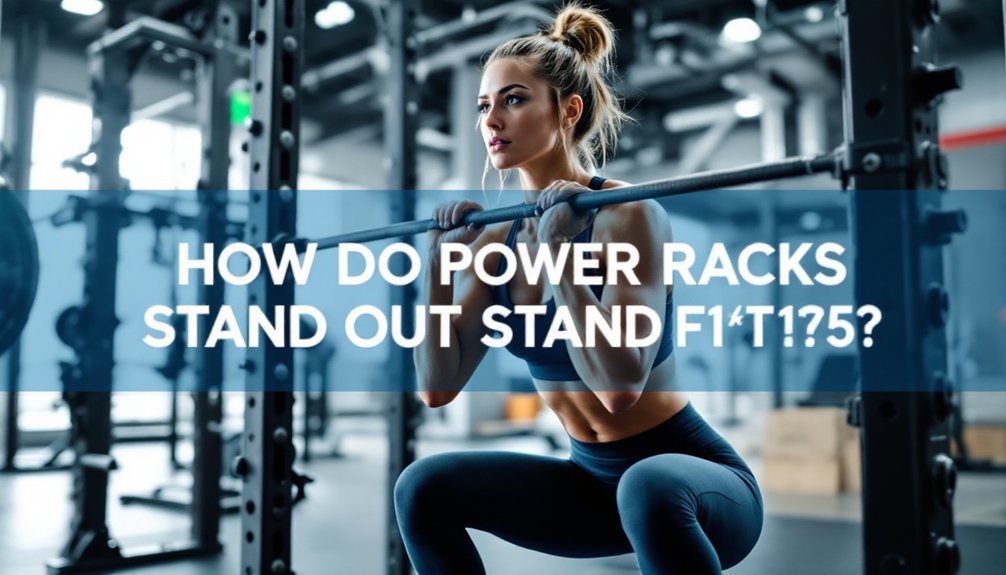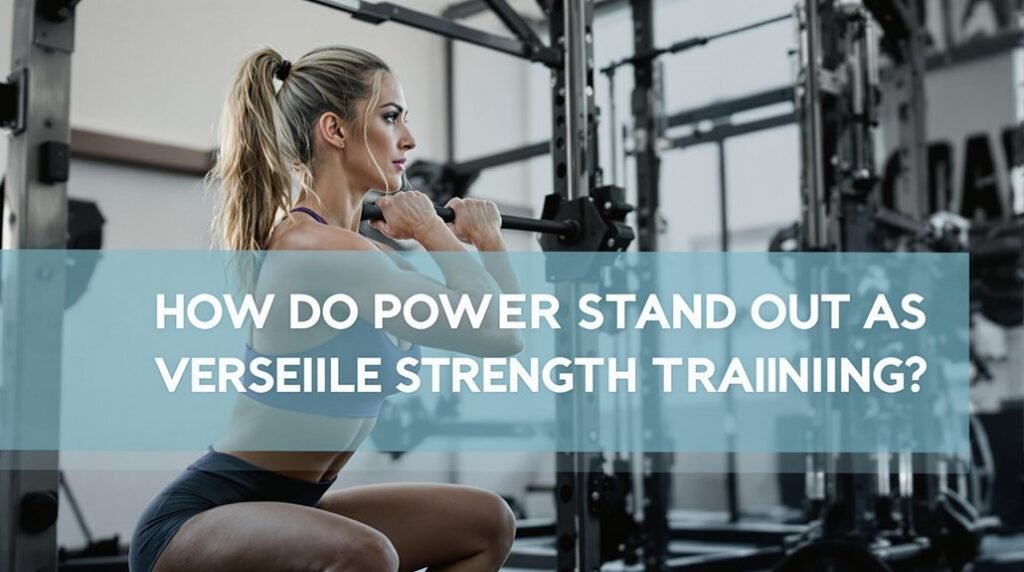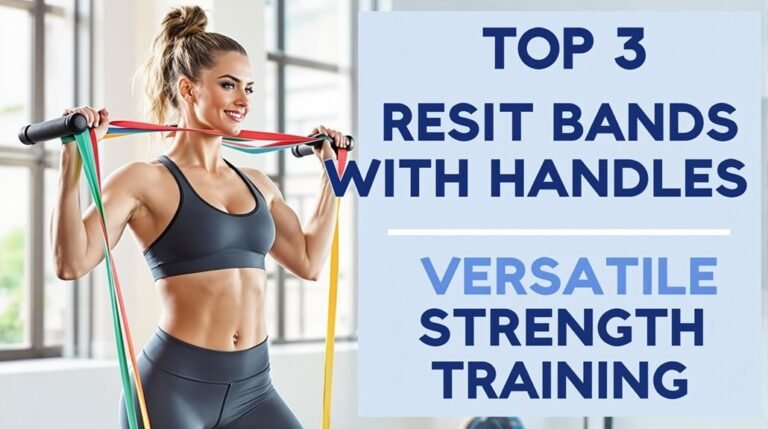Power racks stand out as all-encompassing strength training stations by enabling you to perform multiple exercises safely and effectively. You'll have access to essential compound movements like squats, deadlifts, and bench presses, with built-in safety features supporting up to 1000 pounds of weight. The adjustable J-hooks, safety bars, and pull-up stations let you customize workouts for your body type and fitness level, while space-efficient designs include storage solutions for weights and accessories. Whether you're training alone or pushing your limits, these versatile stations provide everything you need to develop progressive strength gains and master various lifting techniques.
Key Takeaways
- Power racks enable multiple compound exercises like squats, deadlifts, and bench presses within a single station, maximizing workout efficiency.
- Built-in safety features, including spotter arms and adjustable safety bars, allow confident solo training without requiring a human spotter.
- Customizable J-hooks and safety pin positions accommodate different exercises and body types, ensuring proper form and technique.
- Space-efficient designs with integrated storage solutions keep weights organized while maintaining a compact training footprint.
- Additional features like pull-up bars and dip stations expand exercise variety beyond basic lifts, creating a comprehensive training environment.
Multiple Exercise Capabilities

While traditional weight benches offer limited functionality, power racks serve as all-encompassing workout stations that reveal a full range of strength training exercises. You'll discover remarkable exercise diversity through compound movements like squats, deadlifts, and bench presses, all within a single station. Cable machine attachments expand the range of possible exercises even further. Additionally, many power racks come equipped with adjustable bench positions that enhance exercise versatility.
The rack's versatile design enables precise muscle targeting through various exercises, from overhead presses to rack pulls. With adjustable safety bars and J-hooks, you can customize your workout setup for different movements while maintaining proper form. You'll also benefit from integrated features like pull-up bars and dip stations, which expand your training options beyond basic lifts. Whether you're performing partial reps for progressive overload or utilizing band-assisted movements, power racks accommodate your evolving fitness needs through multiple exercise variations.
Built-in Safety Features
When you're lifting heavy weights, your power rack's built-in safety features become your most important training partner, with spotter arms ready to catch failed lifts and prevent dangerous situations. The rack's adjustable safety bars should be positioned 1-2 inches below your lowest squat depth, ensuring you'll never get trapped under a heavy barbell. Additionally, investing in essential cardio equipment can complement your strength training routine for a well-rounded fitness approach. Your rack's sturdy steel frame and solid construction create a stable environment for lifting, with properly welded joints and a robust base that won't tip or shift during intense workouts. Non-slip footplates secure the rack firmly to the ground, eliminating unwanted movement during explosive exercises.
Spotter Arms Save Lives
Since powerlifting demands pushing your limits, spotter arms serve as an essential safety net during solo training sessions. The spotter arm benefits are clear: they'll catch the barbell if you fail a lift, preventing potentially serious injuries when you're training alone.
The rack's magnetic safety pins provide secure and reliable protection during intense workouts. You'll find various safety options in modern power racks, including traditional spotter arms, safety pins, and safety straps. Safety pins provide solid metal protection across the rack, while nylon safety straps offer a gentler catch for the barbell. For ideal injury prevention, you should position these safety features 1-2 inches below your lowest squat position. When properly set up, they'll eliminate the need for a human spotter and allow you to confidently push your boundaries during heavy lifts like squats and bench presses.
Safety Bar Height Adjustments
Setting up safety bar heights properly is one of the most basic yet powerful ways to protect yourself during lifts. The safety bar importance can't be overstated, as these bars act as your last line of defense when a lift fails. You'll want to position them just below chest level for bench presses and at your lowest squat depth for squats.
Your adjustment techniques should focus on securing the bars firmly at appropriate heights. When you're setting them up, slide them along the power rack's vertical posts until they reach the ideal position. The bars require insertion done sideways for proper installation. You'll find different mechanisms, like pins or straps, depending on your rack model. Always test the height before loading heavy weights, and verify both sides are level and locked securely in place.
Sturdy Frame Prevents Accidents
A power rack's robust frame serves as your primary defense against weightlifting accidents. Built with 11-gauge steel and capable of supporting up to 800 pounds, these structures provide essential frame stability and accident prevention during your workouts. The Gravity Lock Safety Catch provides continuous protection for up to 1000 pounds of weight.
Your power rack's sturdy construction offers several critical safety features:
- High-grade steel framework that prevents wobbling during heavy lifts
- Enclosed cage design that keeps the barbell contained within safe boundaries
- Impact-absorbing safety straps to catch falling weights
- Multiple tie-down points for enhanced stability
- Rigid construction that eliminates unwanted movement
The durable framework guarantees you'll have a secure lifting environment for years to come. Whether you're performing squats, bench presses, or other compound movements, you can trust your power rack's solid construction to keep you safe throughout your training sessions.
Training Without a Spotter

Training alone doesn't mean compromising safety when you're equipped with a power rack. These versatile stations provide essential features for solo training and injury prevention, including safety pins, spotter arms, and catch bars that protect you during failed lifts. Investing in a quality power rack can significantly enhance your workout experience.
Before starting your workout, ensure the bench clicks securely into the power rack attachment point. You can customize your power rack with various safety attachments to match your training needs. Set the safety bars just above chest level for bench presses, and position J-hooks to align perfectly with your wrists for peak lift-off. When training without a spotter, you'll want to focus on exercises that don't require assistance, such as dumbbell squats or machine-based movements. If you're attempting heavier lifts, consider reducing the intensity and utilizing the rack's safety features, like spotter arms and straps, to guarantee a secure workout environment.
Customizable Workout Settings
You'll get the most out of your power rack by taking advantage of its adjustable J-hooks and safety pins, which let you customize the height and depth for different exercises and body types. Your workout space becomes more efficient when you properly position weight plate holders and other attachments, keeping everything within arm's reach during training sessions. The rack's versatility extends to storage options, where strategic placement of accessories and proper spacing around the equipment guarantees both safety and convenience during your strength training routine. Additionally, incorporating adjustable dumbbells into your setup enhances the range of exercises you can perform and allows for seamless transitions between workouts. The power rack's comprehensive setup enables you to perform a complete six-exercise workout routine targeting multiple muscle groups.
Adjustable Height and Depth
Flexibility stands at the core of power rack design, with adjustable height and depth settings that let you customize your workout space precisely to your needs. The height benefits include allowing you to position safety bars at the perfect spot for squats, bench presses, and other lifts, while depth advantages offer ideal bar placement and movement space. With standard heights ranging from 80 to 93 inches, power racks accommodate users of all sizes and training styles.
You'll find these essential features in modern power racks:
- Multiple height adjustment holes for precise safety bar positioning
- Variable rack depths, typically ranging from 24" to 36"
- Adjustable pull-up bars to accommodate different ceiling heights
- Safety spotters that can be set at various heights for different exercises
- J-hooks that can be placed at multiple levels for different starting positions
These customizable features guarantee you'll get the most out of your strength training sessions while maintaining proper form and safety.
Storage Options and Placement
Beyond adjustable features, modern power racks offer smart storage solutions that transform your workout space into an organized training hub. With storage flexibility ranging from integrated weight plate posts to customizable attachment holders, you'll maximize your available space while keeping equipment readily accessible. 11-gauge steel construction ensures reliable support for all stored equipment.
| Feature | Storage Benefits | Placement Strategies |
|---|---|---|
| Weight Posts | Easy plate access | Against sturdy walls |
| Cable Systems | Attachment storage | Corner positioning |
| Foldable Design | Space-saving | Room center access |
| Storage Hooks | Equipment organization | Clearance zones |
When considering placement strategies, measure your available space carefully, accounting for doorways and ceiling height. You'll need adequate room for exercises plus storage accessibility. Most power racks require at least 2 feet of clearance on all sides, while folding models can be mounted directly to walls for maximum space efficiency.
Space-Efficient Home Training Solution

Space constraints shouldn't deter you from setting up a robust home gym, as modern power racks offer ingenious solutions for limited spaces. As compact gym solutions evolve, you'll find multi functional equipment that maximizes every square foot of your training area.
Consider these space-efficient options that deliver full workout capability:
- Wall-mounted racks that fold away when not in use
- Half racks with built-in plate storage and pull-up bars
- Compact power racks with adjustable safety features
- Foldable designs that tuck neatly against walls
- Dual-function stations combining rack and storage systems
You'll discover that today's power racks efficiently utilize vertical space while providing thorough strength training capabilities. With features like adjustable safety bars and integrated storage, you're getting a complete workout station that adapts to your available space without compromising on functionality. Half racks like the Self Standing Half Rack offer substantial savings of $400 while maintaining essential workout features. These innovative designs are an ideal fit for any compact home gym setup, ensuring you achieve your fitness goals without overcrowding your space.
Progressive Strength Development Options
When you're ready to take your strength training to new heights, power racks offer an unmatched platform for progressive development. You'll find built-in features that support systematic strength gains while maintaining safety, allowing you to focus on increasing your strength metrics through progressive overload.
| Training Focus | Beginner | Advanced |
|---|---|---|
| Safety Features | Spotter Arms | Adjustable Catches |
| Exercise Range | Basic Compounds | Complex Variations |
| Loading Strategy | Fixed Increments | RPE-Based Loading |
With adjustable safety bars and spotter arms, you can confidently push your limits across various compound movements. The rack's versatile design lets you incorporate pull-ups, bench presses, and squats into your routine, while its weight storage solutions make tracking progressive overload simple and organized. You'll appreciate how the adjustable height settings accommodate different exercises and body types, ensuring consistent progress in your strength journey.
Frequently Asked Questions
How Long Does It Typically Take to Assemble a Power Rack?
Prepare for proper power rack assembly time ranging from 2-5 hours. You'll find it's faster with a helper and following assembly tips like hand-tightening bolts until final steps.
Can Power Racks Be Anchored to Concrete Floors for Additional Stability?
You can anchor power racks to concrete floors for significant stability benefits. Using wedge anchors and proper installation considerations, you'll create a secure foundation for safer, heavier lifts.
What Is the Average Lifespan of a Quality Power Rack?
You'll find a quality power rack's lifespan extends beyond 10-15 years with proper maintenance. It's a long-term strength training investment, and its durability depends on material quality and usage patterns.
Are Power Racks Suitable for Olympic Lifting Movements?
You'll find that power racks can handle Olympic lifts, though they're best suited for modified variations. Their safety features like straps and adjustable bars protect you during overhead movements.
How Much Maintenance Do Power Rack Cables and Pulleys Require Annually?
You'll need to perform daily cable maintenance checks, weekly pulley care with lubrication, monthly professional servicing, and annual cable replacements. Regular inspections help prevent wear and guarantee safe operation.



